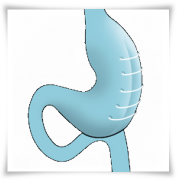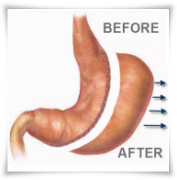Types of Weight Loss Surgery
Weight loss surgery can help you to lose excess weight and improve your health as well as your quality of life, but before choosing the most popular method, you should be come with the different types of weight loss surgery.
Click here to read more about the Gastric Sleeve.
Why Get Weight Loss Surgery?
Obesity can lead to many complications and serious health problems, but there are various types of weight loss surgery that help fight obesity. Individuals that are obese, morbidly obese, or severely overweight are much more likely to develop health problems than those who do not suffer from obesity or are not overweight.
 Obesity can lead to many health problems that can include things like:
Obesity can lead to many health problems that can include things like:
- Diabetes (Type II)
- Heart Disease
- High Blood Pressure
- Hypertension
- High Cholesterol
- Stroke
- Cancer
- Osteoarthritis
- Sleep Apnea
These are just a few of the issues you may have to deal with if you are obese. Many of these conditions may last for the rest of your life, but there are many types of weight loss surgery that can help reduce the risk of developing these conditions, or even eliminate many of these problems altogether. Here we will give you an overview of the different types of weight loss surgery that are available to help you fight obesity.
The Three Main Types of Weight Loss Surgery
Restrictive Surgery
Restrictive types of weight loss surgery work by restricting or reducing the stomach size and slowing down the digestion of food. The normal stomach holds approximately 3 pints of food. Following most restrictive types of weight loss surgery, the stomach will hold about an ounce immediately afterwards, although later on the quantity may increase to 2 – 3 ounces. As the stomach gets smaller, the less food you can eat and ingest, and the less food you are able to ingest, the more weight will be lost.
Restrictive Types of Weight Loss Surgery include:
- Adjustable Gastric Banding
- Vertical Banded Gastroplasty
- Gastric Balloon
- Sleeve Gastrectomy (Gastric Sleeve)
- Gastric Plication
Malabsorptive Surgery
Malabsorptive types of weight loss surgery are more invasive procedures that changes the way you process and digest food. The digestive system is altered, which will make it harder for the body to absorb nutrients and calories. Procedures that are only malabsorptive (which are also called intestinal bypasses) are not performed anymore due to the side effects.
Malabsorptive Types of Weight Loss Surgery include:
- Biliopancreatic Diversion (BPD)
- Jejunoileal Bypass
Malabsorptive/Restrictive Surgery
These types of weight loss surgery are a combination of Restrictive and Malabsorptive types of weight loss surgery. The stomach is reduced in size and the digestive system is altered.
Malabsorptive/Restrictive Types of Weight Loss Surgery include:
- Gastric Bypass Surgery
- Gastric Sleeve With Duodenal Switch
- Implantable Gastric Stimulation
Restrictive Types Of Weight Loss Surgery
Adjustable Gastric Banding
Gastric banding is basically putting a band around the stomach to reduce its size, and is one of the less invasive types of weight loss surgery. An inflatable band is surgically implanted and used to squeeze the patient’s stomach into two smaller sections: a large lower section and a smaller upper pouch. The two sections of the stomach are still connected; but the channel between the two is very small, and this slows down the food traveling from the upper pouch. The smaller upper portion restricts the quantity of food that you can eat. The band can be inflated or deflated to achieve the desired weight, this is the adjustable part of the band. Once the excess weight has been lost, the gastric band will be removed. There are many types of adjustable gastric bands, two of the more popular ones are the REALIZE and the LAP-BAND.
Vertical Banded Gastroplasty
Vertical banded gastroplasty, or VBG, is also referred to as stomach stapling, and is one of the restrictive types of weight loss surgery. Both staples and a band are used to make a smaller stomach pouch, and this slows the food from passing to the digestive system. However, it is quickly become less popular, and many bariatric surgeons are opting for a gastric band instead. The reason is because VBG is classified as a “severely dangerous” procedure. Adjustable gastric banding does not involve cutting the stomach, and staples are not required, making the adjustable gastric band a safer alternative. If you can avoid the vertical banded gastroplasty, we would recommend that you do so.
Gastric Balloon
The Gastric Balloon works by artificially reducing the stomach size. A special type of balloon is deflated and inserted into the stomach through the mouth and down the throat. It is then inflated with a special solution to the desired size, and this reduces the amount of food that can be ingested. This is the least invasive method of all the types of weight loss surgery, no incisions are required, and the procedure is completely reversible. The gastric balloon can remain in the body for a maximum of 6 months, but this technique can be used repeatedly.
Sleeve Gastrectomy (Gastric Sleeve)
This is one of the newer types of weight loss surgery. As you’ve read elsewhere on this site, approximately 60% – 85% of the stomach is removed, and remaining stomach is shaped like a tube, or a ‘sleeve’. This smaller stomach permanently limits food intake, which leads to weight loss. The gastric sleeve can be followed by a second bariatric procedure, usually a biliopancreatic diversion or a gastric bypass, which leads to further weight loss, but in many cases, the gastric sleeve may be the only procedure you will need.
Gastric Plication
This procedure is similar to the gastric sleeve. A sleeve shaped stomach is created, but instead of cutting stomach tissue away, the stomach is sutured. This is probably the newest types of weight loss surgery, but results thus far have been comparable to that of the gastric bypass.
Malabsorptive Types Of Weight Loss Surgery
Biliopancreatic Diversion (BPD)
Biliopancreatic diversion involves redirecting food to a lower part of the intestines, and is one of the more invasive types of weight loss surgery. The patient can still enjoy a free diet because there is no restrictive component. Basically, the stomach is disconnected from the duodenum and then connected to the Ileum. Food then bypasses the Jejunum and the Duodenum, which results in less nutrients and calories absorbed by the body. However, this types of weight loss surgery can cause severe nutritional deficiencies that can lead to diseases such as osteoporosis and anemia. Biliopancreatic diversion is a very complex procedure and is one of those types of weight loss surgery that is rarely performed any more due to the problems with malnourishment, extensive monitoring and the life-long need for nutritional supplements. Instead of BPD, bariatric surgeons prefer a duodenal switch.
Jejunoileal Bypass
This is a surgical bypass procedure done to reduce absorption of nutrients and calories in the patient’s small intestine. It involves attaching the initial part of the jejunum to a lower part of the Ileum. This is another one of the types of weight loss surgery that was performed from the 1950s to the 1970s, but is not performed any more due to the complications and issues with bacterial overgrowth.
Malabsorptive/Restrictive Types of Weight Loss Surgery
Gastric Bypass Surgery
A popular form of the gastric bypass surgery is called the Roux-en-Y gastric bypass. This is a two-stage procedure, where a smaller stomach pouch will first be created by employing the Gastric Sleeve procedure. The second stage is the bypass, where the new stomach is then connected to a lower part of the small intestine. The upper portion of the patient’s small intestine will then be reattached in configuration shaped like a ‘Y’. The gastric bypass is one of the most performed types of weight loss surgery, with roughly 145,000 procedures performed each year.
Gastric Sleeve With Duodenal Switch
This procedure is composed of two stages, the first being the Gastric Sleeve where the stomach size is significantly reduced. The second stage is where new stomach is disconnected from the patient’s duodenum and then reconnected to a lower part of the small intestine. The top portion of the small intestines and the duodenum are then reattached to the rest.
Implantable Gastric Stimulation
In this procedure, a device that is similar to the heart pacemaker is surgically implanted. The device has electrical leads that stimulate the surface of the patient’s stomach. Electrical stimulation can theoretically modify activity of the nervous system of a patient’s stomach giving a feeling of fullness even though a lower quantity of food has been eaten. This is one of the newest types of weight loss surgery, and the procedure is still being studied, but initial reports indicate that this type procedure is not as effective as other types of weight loss surgery.

